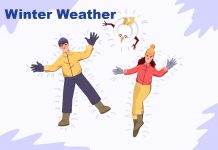Major Spring Snowstorm Moves In—Heavy Snow and Whiteout Conditions Expected
THUNDER BAY – WEATHER – Winter conditions with a vengeance are in store for Thunder Bay and region, where a Winter Storm Warning remains in effect this Wednesday.
The NetNewsLedger Weather Desk is forecasting a wallop of snow—20 to 30 cm, with locally higher totals west of the city in elevated terrain. Add in gusty winds and blowing snow, and you’ve got a full-fledged spring snowstorm on your hands.
Today’s Forecast: The Calm Before the Blizzard
At 5:00 AM EDT, the Thunder Bay Airport reported mostly cloudy skies, a temperature of -0.1°C, and a dew point of -2.8°C. Humidity is 82%, and winds from the southeast at 20 km/h, gusting to 30 km/h, are already adding a bite to the air with a wind chill of -5°C. Visibility currently sits at a healthy 24 km, but don’t expect that to last.
Heavy snow and blowing snow will begin late this morning, with snow intensifying through the afternoon and evening. Peak snowfall rates of 3 to 5 cm per hour could significantly reduce visibility and pile up snow quickly, especially during the evening commute.
School Buses Cancelled!
Tonight: Howling Winds and Accumulating Snow
By tonight, the snow machine will still be running strong. An additional 10 cm of snow is forecast overnight, driven by easterly winds gusting up to 70 km/h, especially near open areas downwind of Lake Superior. These winds will create blizzard-like conditions, particularly in rural and exposed regions.
Temperatures will drop to -1°C overnight, but it’ll feel more like -8°C with the wind chill. Driving may become hazardous, if not impossible, in some areas. If you’re planning any non-essential travel, consider rescheduling.
Thursday Outlook: Storm Eases with Flurries and Cloud
The worst of the storm should wind down by early Thursday morning, tapering to flurries with cloudy skies. Winds will finally back off, shifting to the northwest at 20 km/h, and daytime temperatures will rise to a high of +5°C. Still, road conditions may remain treacherous with lingering snow and slush, so go slow and be ready for cleanup efforts.
Looking Ahead: A Break in the Clouds, But Not in the Cold
Friday offers a much-needed reprieve with a mix of sun and cloud and a high of +7°C. However, flurries or showers could return by evening. The weekend brings more of the same—on-and-off flurries and temperatures ranging from +1°C to +3°C, with overnight lows dipping as far as -11°C.
Deep Dive into Today’s Weather
Lake Superior West Marine Forecast: Gale Warning in Effect with Heavy Snow and Rough Seas
Mariners Advised to Exercise Extreme Caution as Winds Strengthen and Waves Build
For those navigating Lake Superior West, conditions are set to deteriorate significantly beginning this morning. A Gale Warning is in effect, and with heavy snowfall, reduced visibility, and rough waters, marine travel is strongly discouraged unless absolutely necessary.
Wind Forecast: Gale-Force Winds Incoming
Issued at 3:00 AM EDT, April 2, 2025, today’s marine outlook begins with southeast winds at 25 knots, increasing to a gale-force 35 knots near noon. These powerful winds will ease to 30 knots by this evening, shifting eastward.
By Thursday morning, winds will diminish further to northwest 20 knots, then back to west 15 knots by noon, and taper off again to northwest 10 knots by Thursday evening. Although the Strong Wind Warning Program has ended for the season, today’s conditions are a stark reminder that Lake Superior doesn’t check the calendar.
Wave Forecast: Rough Seas Through Tonight
Waves are currently 1.5 metres, building to 2 to 3 metres early this morning, and reaching 3 to 4 metres by this afternoon—a rough and dangerous ride for smaller vessels. Expect waves to subside to 2 to 3 metres near midnight, 1 to 1.5 metres by Thursday morning, and finally easing to 0.5 to 1 metre Thursday afternoon.
Weather & Visibility: Snowfall and Limited Sightlines
Snow will develop across the lake this afternoon, continuing through tonight and into Thursday morning. Visibility will drop to 1 mile or less in snow, making navigation extremely hazardous. Combined with the wave action and wind gusts, conditions will be challenging even for experienced mariners.
Marine Safety Reminder: Lake Superior’s Spring Surprises
Lake Superior may be surrounded by signs of spring, but its surface remains a powerful and unpredictable environment this time of year. With gale-force winds, high waves, and snowfall, mariners are urged to remain docked unless travel is essential.
Historic April 2 in Thunder Bay
Thunder Bay’s warmest April 2 came in at 15.7°C (1953), while the chilliest was a bracing -23.3°C (1965). Today, with 30 cm of snow and winds roaring off Lake Superior, it’s clearly leaning into its wintry legacy rather than spring’s promise.
What to Wear: Arctic Battle Gear Required
Layer up like it’s mid-February. Insulated parka, snow pants, waterproof gloves, and sturdy winter boots are essentials today. If you’re heading outside, goggles wouldn’t be out of place—visibility will drop fast in the heaviest snow and blowing gusts. And yes, your snow shovel’s about to earn its keep.
Thunder Bay Weather Trivia: Lake Superior’s Snow Enhancer
Did you know? Thunder Bay’s proximity to Lake Superior often intensifies snowfall during easterly wind events. The added lake moisture helps build snow bands that can drop significantly more snow just west of the city—an effect you’re likely seeing today.






